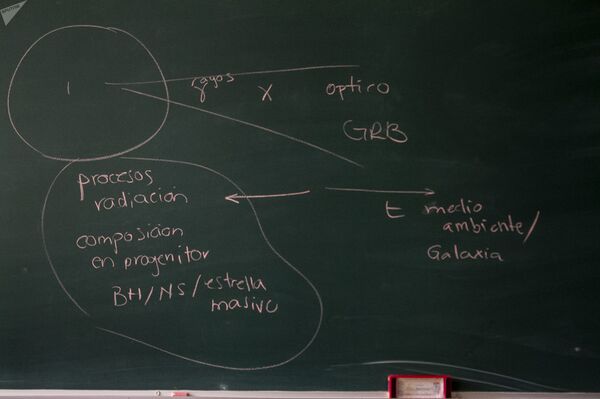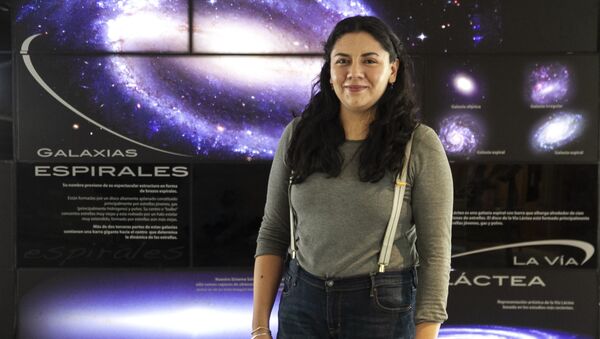“Before we only had photos,” Rosa Becerra, an Astrophysics Professor from the National University of Mexico (NUM), explained. Now, the study of gravitational waves opens great perspectives for the understanding of space."

Rosa Becerra is one of the young scientists who pioneered the study of gravitational waves in the country right after the new telescope had been launched. The tool, named Coatli, is located in the National Astronomical Observatory of San Pedro Mártir, in Baja California.
The young scientist first completed her Bachelor’s degree in Physics and then her doctorate at the NUM Astronomy Institute. Rosa worked on the development of a new reflector, conducted various experiments, and, eventually, the telescope turned into a tool that brought newfound fame to Mexican astronomers.

The Ratir camera that was placed on a 1.5-metre telescope in San Pedro Mártir has many filters that allow for the study of various characteristics of the same object.
“We installed Coatli a year and a half ago, and it’s currently used specifically for monitoring the optical manifestations of gamma-ray flashes,” Becerra said.
A Super-Fast Telescope
30-year-old Becerra got her doctorate in astronomical research at the NUM. It was then that she devoted herself to studying how to obtain better telescopic images of the farthest universe, through the development of optical techniques that improve real time image capture.
“While working on my MSc Dissertation, I dedicated myself to improving a reflector that was later installed in Puebla, in the National Observatory of Tonantzintla. As soon as the device started operating, the budget was approved to make the Coatli telescope the telescope of San Pedro Mártir, which I used for my doctorate,” the scientist said.
Professors Alan Watson and Salvador Cuevas from the Institute of Astronomy were responsible for the Coatli Project. Becerra was part of this avant-garde team; she reoriented her work and research towards the study of optical manifestations of gamma ray flashes.
“These are the traces we have after a very massive star dies or when two neutron stars or black holes collide. This event first throws out gamma rays, then starts emitting X-rays and then there is optic and radio emission,” she explained.
Ver esta publicación en Instagram
Both gamma rays and X-rays are trapped in the Earth’s atmosphere, so scientists need space missions to detect such of emissions in the universe. Scientists have long been making optical and radio observations, but not those of gamma ray flashes.
“Gamma-ray flashes occur every day. There are special NASA programmes and equipment with gamma-ray sensors. When they are detected, they inform us about that,” Becerra said.
There the Coatli steps in; it’s a robotic telescope 50 centimetres in diameter designed to study the results of these events, the earliest of which happened many years ago, outside the Milky Way.

Unlike the planets –which will always be where they are – “these events are transient, they only last a few seconds,” Becerra pointed out.
When a very massive star, 50 times the size of the sun, explodes because it no longer has energy to burn, or when two neutron stars begin to close in until they collide, they generate a series of gamma-ray flashes that only last a few seconds.
“The telescopes in San Pedro Mártir are always on to receive the signal, stop what is being done, turn to where the event happened and start receiving data. Our telescopes can move very fast, so that we could start measuring how the object’s luminosity or brightness changes over time as soon as when we get the signal,” the researcher explained.
The information obtained allows astronomers to study the environment in which the event took place, and to determine the gas that surrounded it, the magnetic field, the temperature, density and pressure of the environment.
“We can also find out about the causes of that particular event,” Becerra said.
A Race for Gamma Rays
As they are very brief, gamma-ray flashes present a challenge for their study. The “longest” of them, which last more than two seconds, are associated with the death of massive stars, while the “short” ones – less than two seconds – are the result “of the collision of two compact objects such as black holes or neutron stars.”
“Studying these phenomena, we’ve learned that before in the universe, there were more star formation processes than we have now,” the astronomer said, showing a diagram on her computer.

“With the Coatli we had a chance to observe the gamma-ray flash just 20 seconds after it occurred. The time doesn’t depend on the Mexican research equipment but on the time it takes to send the satellite signal to our email that gives the order to the telescope to monitor a certain area in space. This is the problem that we cannot solve,” Rosa Becerra explained.
However, this hasn’t prevented the Coatli from becoming the fastest telescope to measure gamma-ray flashes, thus helping Mexican researches make significant progress in understanding these hugely complicated extragalactic matters.
“When we manage to catch emissions as quickly as possible, we are able to see more of the centre of the star, its environment, the gas; and all this helps us learn more about the galaxy,” she added.
According to Rosa, when the general public became aware of new data on the nature of gravitational waves, it aroused great interest in the study of these new ways of observing the universe, which don’t depend solely on research into the properties of light rays.
The main focus of Becerra’s team is currently expanding the parameters of the objects under study; she herself, as she says, will be engaged in making "numerical simulations to new types of research”.
“You cannot replay the event in space, but you can do it with a computer. You can change whatever conditions and parameters and replay the event, thus learning what happened before and what led to that event happening,” the astronomer told Sputnik.

It was in August 2017 that scientists first learned that these events also generate gravitational waves, which, unlike light, cannot be detected with a camera. To document them, completely different devices are needed.
“Thus, various human senses, each of which complements the information received, make it possible to build a complete picture of the environment. We already have sensors that detect how space alters, and measure the gravitational waves that are generated around the events we study. And since our telescope responds faster than others, it’s better for the study of these gravitational waves. Using this telescope, we can understand more; and that is why have made significant progress in our work,” Rosa Becerra concluded.




